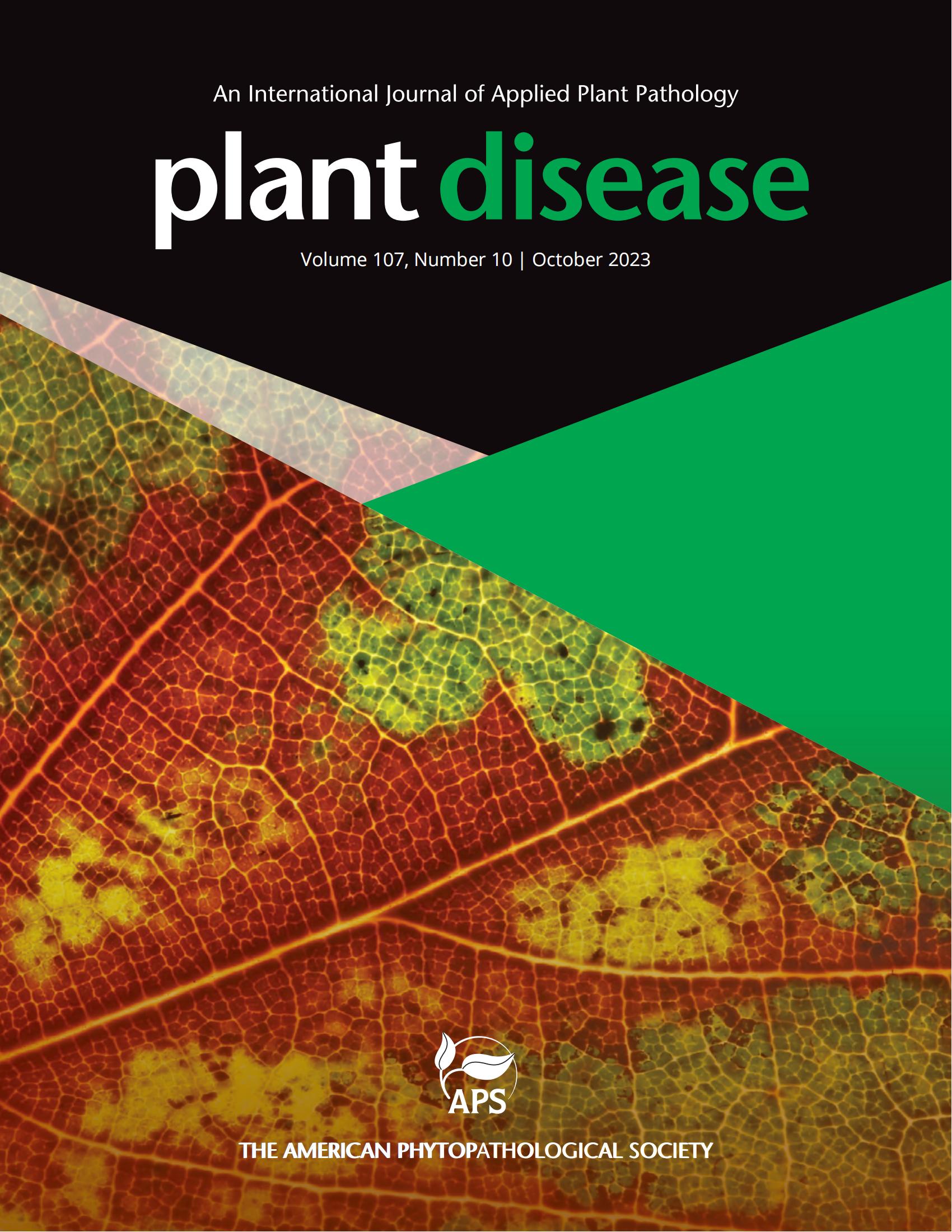Chung-Ying Ho, Eva C Henningsen, Ssu-Tung Chen, Hiran A Ariyawansa, Eric S Nazareno, Jana Sperschneider, Peter N Dodds, Jakob Riddle, Shahryar F Kianian, Melania Figueroa, Yung-Fen Huang
求助PDF
{"title":"Confirmation of Oat Crown Rust Disease in Taiwan.","authors":"Chung-Ying Ho, Eva C Henningsen, Ssu-Tung Chen, Hiran A Ariyawansa, Eric S Nazareno, Jana Sperschneider, Peter N Dodds, Jakob Riddle, Shahryar F Kianian, Melania Figueroa, Yung-Fen Huang","doi":"10.1094/PDIS-04-24-0838-RE","DOIUrl":null,"url":null,"abstract":"<p><p>Oat is a minor forage crop grown in Taiwan. Only a few historical records of oat rust disease have been reported in the country. Therefore, the pathogen population remains poorly characterized. A rust-like disease outbreak was detected at the Experimental Farm of National Taiwan University in 2019, which caused significant damage to field experiments. To determine the identity of the pathogen responsible for this disease outbreak, we collected infected foliar material. Disease signs suggested infection by the oat crown rust fungus. Hence, common procedures in rust pathology were applied to confirm the identity of the pathogen with phenotypic and molecular diagnostic techniques. A total of 50 field pathogen samples from infected oat cultivars were collected in 2019, and 5 single-pustule rust isolates were obtained in 2020 and 2021. These isolates were initially identified as <i>Puccinia coronata</i> var. <i>avenae</i> f. sp. <i>avenae</i> (<i>Pca</i>) based on the phylogenetic analysis of nuclear ribosomal internal transcribed spacer sequence data. This identification was subsequently confirmed through whole-genome phylogeny, which showed that the representative Taiwanese isolate NTU1 clustered with other <i>Pca</i> representative strains in Basidiomycota. Phenotyping assays across 36 oat differential lines demonstrated that Taiwanese isolates are phenotypically similar with relatively low virulence. This study presents the first molecular confirmation of <i>Pca</i> in Taiwan and reports the virulence profiles of the Taiwanese <i>Pca</i> population.[Formula: see text] Copyright © 2025 The Author(s). This is an open access article distributed under the CC BY-NC-ND 4.0 International license.</p>","PeriodicalId":20063,"journal":{"name":"Plant disease","volume":" ","pages":"PDIS04240838RE"},"PeriodicalIF":4.4000,"publicationDate":"2025-03-21","publicationTypes":"Journal Article","fieldsOfStudy":null,"isOpenAccess":false,"openAccessPdf":"","citationCount":"0","resultStr":null,"platform":"Semanticscholar","paperid":null,"PeriodicalName":"Plant disease","FirstCategoryId":"97","ListUrlMain":"https://doi.org/10.1094/PDIS-04-24-0838-RE","RegionNum":2,"RegionCategory":"农林科学","ArticlePicture":[],"TitleCN":null,"AbstractTextCN":null,"PMCID":null,"EPubDate":"","PubModel":"","JCR":"Q1","JCRName":"PLANT SCIENCES","Score":null,"Total":0}
引用次数: 0
引用
批量引用
Abstract
Oat is a minor forage crop grown in Taiwan. Only a few historical records of oat rust disease have been reported in the country. Therefore, the pathogen population remains poorly characterized. A rust-like disease outbreak was detected at the Experimental Farm of National Taiwan University in 2019, which caused significant damage to field experiments. To determine the identity of the pathogen responsible for this disease outbreak, we collected infected foliar material. Disease signs suggested infection by the oat crown rust fungus. Hence, common procedures in rust pathology were applied to confirm the identity of the pathogen with phenotypic and molecular diagnostic techniques. A total of 50 field pathogen samples from infected oat cultivars were collected in 2019, and 5 single-pustule rust isolates were obtained in 2020 and 2021. These isolates were initially identified as Puccinia coronata var. avenae f. sp. avenae (Pca ) based on the phylogenetic analysis of nuclear ribosomal internal transcribed spacer sequence data. This identification was subsequently confirmed through whole-genome phylogeny, which showed that the representative Taiwanese isolate NTU1 clustered with other Pca representative strains in Basidiomycota. Phenotyping assays across 36 oat differential lines demonstrated that Taiwanese isolates are phenotypically similar with relatively low virulence. This study presents the first molecular confirmation of Pca in Taiwan and reports the virulence profiles of the Taiwanese Pca population.[Formula: see text] Copyright © 2025 The Author(s). This is an open access article distributed under the CC BY-NC-ND 4.0 International license.
台湾燕麦冠锈病确诊。
燕麦是台湾种植的一种次要饲料作物。台湾仅有少数燕麦锈病的历史记录。因此,病原体种群的特征仍然不甚明了。2019 年,台湾大学实验农场爆发了燕麦锈病,对田间试验造成了严重破坏。为了确定导致此次病害爆发的病原体,我们收集了受感染的叶片材料。病害迹象表明是燕麦冠锈菌感染。因此,我们采用了锈病病理学的常用程序,通过表型和分子诊断技术来确认病原体的身份。2019 年共从受感染的燕麦栽培品种中收集了 50 份田间病原体样本,2020 年和 2021 年获得了 5 个单一的脓疱锈菌分离物。根据 nrITS 序列数据的系统发育分析,这些分离物被初步鉴定为 Puccinia coronata var.随后通过全基因组系统发育证实了这一鉴定结果,结果显示台湾的代表性分离株 NTU1 与其他 Pca 代表株聚类在 Basidiomycota 中。36 个燕麦差异品系的表型分析表明,台湾分离株表型相似,毒力相对较低。本研究首次从分子水平确认了台湾的 Pca,并报告了台湾 Pca 群体的毒力特征。
本文章由计算机程序翻译,如有差异,请以英文原文为准。

 求助内容:
求助内容: 应助结果提醒方式:
应助结果提醒方式:


